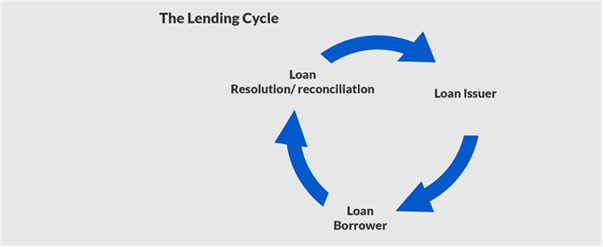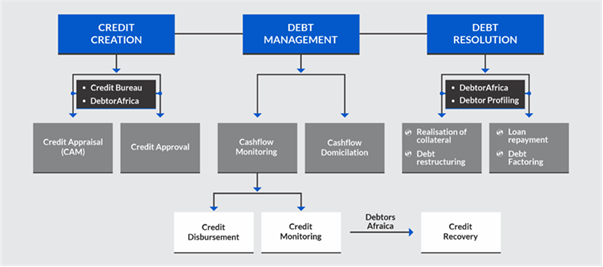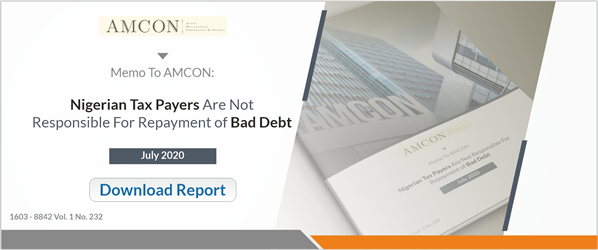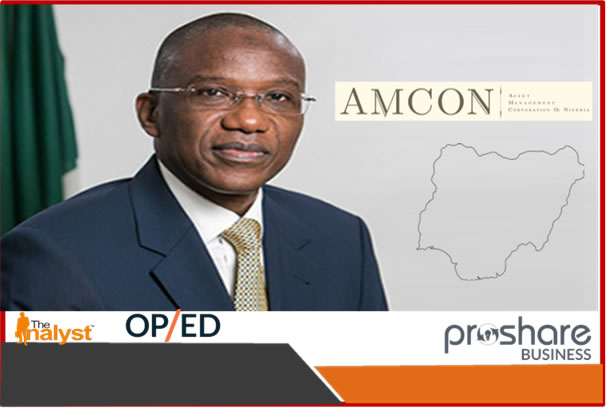Thursday, 23 July 2020 / 13:57PM / Adesola Borokinni and Adaeze Nwachukwu,Proshare Research / Header Image Credit: Ecographics
Recent statements by the Central Bank of Nigeria's (CBN's) assetresolution company, AMCON, and in particular, the Managing Director (MD) on thematter/in regards to the likelihood of public sector resources being used toclean-up N5trn in toxic banking sector loan assets. Analysts have noted thatAMCON's conjecture may have been propped by a mistaken premise.
Specifically, we refer to the pronouncement documented in the PointNGnews story titled - Nigeriantax payers may bear burden of unrecovered N5tn debt, AMCON warns of July 19, 2020.
Coming after our release of the May 13, 2020 Debtors Africa Reporton debtors and NPL's in banks, and theextensive work done thereafter; it was another example of misinformation thatneeded to be addressed, especially one from the regulator.
The resolution company created in 2010 at the height of the assetdelinquency challenges faced by banks at the time raised N1.7trn by way of abond issue to the CBN to buy off toxic assets from banks and reinject freshfunds to support systemic liquidity and protect depositor liabilities. Thearithmetic of the current situation suggests that so far AMCON has recoveredN1.1trn which represents 65% of the amount committed by the company to theprotection of domestic deposit liabilities and systemic stability.
The N5trn alluded to by, Mr Ahmad Kuru, the incumbent chief executive ofAMCON, refers to the face value of the toxic loans outstanding.
A number of clarifications need be set as follows:
- AMCON is obliged to recover the money that it raised from the CBN by way of a bond and therefore is required to recover the N1.7trn.
- The face value of outstanding toxic loans is being written down by a banking sector sinking fund designed to pay off the bad loans from a deduction of 0.5% of the systems total assets. Not immediately verifiable data suggest that the sinking fund was N139.13bn in 2017, N154.98bn in 2018 and N167.90bn in 2019.
- No supposed 'sunset clause' will wind up AMCON in ten years (or by 2020) as presumed in the reported AMCON statement on the use of public funds to cover N5trn of delinquent loans. The initial ten (10) year-target was based on the assumption of an average growth rate of total bank assets of 15% annually at a time annual bank asset growth was about 22%. In the event that banking sector asset growth slowed down the resolution company]s shelf life became naturally extended. More recently bank-wide asset growth has been between 5 and 6%.
- Loan recovery is less complicated than it may appear at first. Only 350 Nigerians are responsible for 80% of the N5trn in toxic assets outstanding. The narrow spread of delinquent borrowers means that AMCON's recovery efforts should stay focused on the recovery of N4trn in toxic asset face value. A recovery of 70% of this amount should be seen as a clear win as even the best recovery rates of bad loans in countries like Malaysia is around 58%.
- A noticeable proportion of toxic assets have been recovered by way of seizure of landed property, machinery and buildings, but the problem is that in an environment of low liquidity and slow economic growth monetizing these recovered assets has become a high hurdle.
At its inception, AMCON identified 10 banks withsystemic credit challenges and subsequently injected N736bn liquidity to buy upthe toxic assets. With the structured repayment plan under a sinking fundarrangement the suggestion that public funds would be needed to cover theindebtedness of the banking sector is odd.
The evidence available indicates that with expansionin bank-wide total assets as the economy picks up will lead to accretions tothe sinking fund which in turn would write-off toxic asset size over time.Furthermore, the growth in the domestic economy would increase asset values andmake the local investment market more attractive resulting in fresh fundsflowing into the real estate business as foreign direct investors buy into the economyin search of superior market yields, enabling AMCON sell off stranded assets attidy profits , thereby paying down the N5trn delinquent loans on the resolutioncompany's balance sheet.
Understanding the State of Play
Since its inception AMCON has acquired over 12,000non-performing loans worth N3.7trn from 22 commercial banks and injected overN22trn as financial accommodation to 10 banks. AMCON has been able to recoverover N1.1trn while its total obligation to the central bank of Nigeria was overN5trn. In a recent presentation by Mr. Aliyu Kalgo on behalf of AMCON's boss,Mr. Ahmed Kuru, Kalgo noted that AMCON was unable to recover its outstandingdebt of over N5trn and noted that the debt burden would become the debt of thefederal government and local taxpayers.
The statement, though well-meaning, wrongly interpretsthe financial accommodation principle guiding the establishment of AMCON. Thefinancial accommodation meant that AMCON was to recover what it paid for toxicloans. The bank's sinking funds were expected to pay for the majority of theliabilities of the banks. The difference between the bank's loan purchaseamount and the balance with AMCON was referred to as 'financial accommodation'.Therefore, financial accommodation was not AMCON's responsibility to recoverbut that of the banking system through a sinking fund.
According to the guiding principle of itsestablishments, the taxpayers should not be a party in the debt recoveryprocess. Major parties to credit recovery include AMCON itself, the CBN,Deposit Money Banks (DMBs), Credit Bureaus, NDIC, and delinquent debtors.Therefore, recoveries by AMCON, note financial analysts, cannot be used as afiscal cushion to help plug budgetary gaps of the federal government andneither should the debt burden resulting from an inability to recover toxicloans be shifted to taxpayers. Therefore, as far as corporate financeprofessionals are concerned, AMCON at no time had the legal right or fiscalresponsibility to give the federal government money for whatever purposeneither does it have the right to transfer burdens of debt.
A grey area that is yet to be properly clarified isthe role of NDIC. NDIC was saddled with the role of charging insurance premiumson the deposits of distressed institutions. The insurance premiums charged weresupposed to insulate depositor's funds in the case of the collapse of a bank.Therefore, NDIC's role was faulted as there was no reason for NDIC to collectinsurance premiums during bank failures when AMCON was covering the cost.
But the NDIC has collected premiums from banks whichwere beneficiaries of AMCON intervention meaning that AMCON was paying money tothe federal government through NDIC. According to ChikeObi, "if theadjustments for NDIC payments to the federal government by way of premiumpayments on deposits are added to the taxes paid to the government by nowprofitable banks the money made available to the federal government by AMCONwould be in the region of N2trn."
The New Grail
To validate Proshare's position, a discussion with Mr. Mustapha Chike-obi, erstwhile chief executive of AMCON, gave some confirmation of the evidence-based arguments. Accordingto Chike-Obi, all AMCON needs to recover is what it paid for the loans. Therecovery of the balance of the face value of loans outstanding on the assetresolution company's books was to be amortized and recovered by a sinking fundcreated for the industry's toxic assets. The bank's loan purchase amount wasabout N1.7trn, the balance of N4trn was what AMCON called, 'financialaccommodation'. The accommodation was supposed to be paid back by the sinkingfund, and represents what the banks at the time had lost. Based on this playbook,Chike-Obi believed that it was incorrect to say that AMCON bought loans ofN6trn.
The sum of N6trn represents the face value of theloans outstanding at the time of intervention but did not represent the amountthat AMCON paid. The N6trn was made up of N1.7trn that AMCON paid for eligibleloans (EBLs) and N4.7trn represented the money that AMCON gave to the banksas financial accommodation to ensure that depositors wereprotected from loss. The financial accommodation was not AMCON's responsibilityto recover but that of the banking system through the sinking fund.
According to Chike-Obi, "Sanusi and Idiscussed mentioning the face value of the loans, and Sanusi prevailed that weshould make the face value of the loans public in line with policy transparencyand adherence to proper corporate governance standards. Sanusi felt this wouldgive the loan resolution body greater flexibility in pursuit of recovery"
"If a borrower was in a hole for N1bn, AMCONonly needed to go for recovery of between N300m and N400m, but Sanusi felt thatthe agency should go for the full face value of the loan thereby putting alesser burden on the systems sinking fund".
Chike-Obi also noted that the highest recovery rateglobally, occurred in Malaysia which was about 58%. AMCON's target was 70%asset loss recovery. So, of the N1.7trn the agency paid for bank loans, itsactual target was 70% of that or what came to roughly N1.2trn. AMCON presentlyhas recovered about N1.1trn according to the current Chief Executive of AMCON,Ahmed Kuru. The N1.1trn recovery represents 92% of the debt resolutioncompany's target of 70% recovery of its N1.7trn paid to banks. Based on thesenumbers, Chike-Obi may be correct in stating that the agency has done a goodjob of meeting its initial debt resolution mandate. Chike-Obi's position may beat variance with the frustration of the agency's asset management partners(AMPs) who have expressed concern over the style and strategy of the agency inrecovering delinquent debt, but premised on targets set by the CBN for thebody, AMCON appears to have delivered on the original agency target.
An interestingly compelling point that Chike-Obiequally makes concerning the recently mentioned N5trn face value of AMCON debtsis that no bank would sell for 40kobo on every 100kobo face value an asset itstrongly believed was worth at least 60kobo on the naira. Besides, Chike-Obialso noted that a number of the banks had already made certain provisions forthe diminution in loan asset values on their profit and loss (P&L)accounts.
So how does CBN come in on the issue of bad bankloans? Chike-Obi argues that CBN has nothing to do with bad bank loans. In hiswords, "CBN bought AMCON bonds worth N5trn, the question is whether CBNcan recover the N5trn invested in AMCON bonds? From AMCON's model, the CBN isgetting N400bn a year from the sinking fund. The CBN should get its money backif not in 10 years then in 15 years. So, what the CBN has on its books is AMCONbonds". The bond is being serviced by the sinking fund and AMCON. CBNhas nothing on its books on AMCON other than the bond investment.
A tricky area of AMCON's playbook is a situation wherethe agency recovers more than was required by the recovery formula, suppose aN1bn debt AMCON was required to recover N300m (30kobo on a naira). SupposeAMCON recovers N500m, does the additional N200m go to the sinking fund? No, itdoes not.
Chike-Obi agreed that one of the most profitableaspect of the AMCON delinquent debt was the loans without collateral that werepurchased at 5%. Many of these debts, according to Chike-Obi, "wererecovered 100%". The excess of money recovered over and above thatrequired by the AMCON recovery target goes into a pool of recovered loans. Theformer AMCON boss reiterated that all AMCON can ever do with recovered money isto pay down its debt.
Fighting the Tyranny of Debtors
The problem of chronic debtors in the banking sectorhas been a perennial concern for some years. One of the major challenges of thelocal lending cycle in Nigeria is that lenders which are the banks have becomevictims of the tyranny of bad and delinquent debtors.
Some of these bank debtors are high profileindividuals and people with political influence, therefore, worsening banks' ability to recover delinquent loans. CBN has adopted various policies to reducethe incidence of bad loans in Nigeria. In 2015, CBN issued a directive titled"Recovery of Delinquent Credit Facilities" to all Nigerian banks and discounthouses, to give delinquent debtors a three-month grace failure by these debtorsto make recompense within the grace period will lead to the names of thesedebtors being published in three (3) national dailies which is expected to bequarterly.
However, the question arises whether the "name andshame" strategy and blacklisting of the defaulting creditors constitute theright approaches to dealing with credit defaulters. These strategies may beviewed as severe and beg the question how banks can avoid delinquent loans inthe first place.
The latest strategy adopted by CBN is the GSI (GlobalStanding Instruction) guidelines issued by banking sector regulator. The GSIcontains notable provisions on the obligations of a borrower to execute a GSImandate permitting a creditor bank to debit any of its bank accounts inNigeria, in repayment of the loan facility availed the borrower. As previouslynoted, the GSI was prompted by the need to reduce the incidence of delinquentloans in the financial sector.
The New Approach
Withopportunities for better debtor profiling before loans are granted, a reportwritten by Proshare Nigeria but commissioned by DebtorsAfrica earlier in the year noted that the domestic loan process can bede-risked by improved borrower knowledge and monitoring. The Debtors Africa report noted that the useof digital registers of borrower's activity across the financial servicesector provides a loan marker which enables new lenders insight into thecharacter of the borrower. The new approach would embed a customer's borrowingjourney into a digital framework that can be reviewed by lending institutions.The digital register differs from a credit bureau; while a credit bureauprovides a scoring system to determine whether a borrower is a fit and properperson to take a loan, the digital register is a dynamic record of strictly delinquentand hardcore borrowers. The record looks at the amount outstanding, thecustomer address and business, and details of directors if the customer is acompany. The register replaces the old perishable "name" and "shame" approachtried by AMCON and Access Bank Plc. The "perishability" of hard copy print listof delinquent customers makes its effectiveness limited. However, a digitallist of bank customers that are delinquent or unwilling to pay debts is morepermanent and overcomes the psychological impact of "saliency" and "recency".
Illustration 1: Lending Cycle

Theonline digital register is a quick recourse for base rate references on aprospective borrower's existing credit position. The lender can screen theborrower while also assessing the character of the corporation or individualconcerning recent and past loans received. The register could serve as apre-emptive tool at the point of loan appraisal, a digital monitor at the pointof loan administration, and a loan recovery tool at the point of loanrepayment.
Illustration 2: Debt recovery/Managementnew indicative paradigm

Going Forward
AMCON must evolve and reset its internal and externalengagements to ensure better monitoring of loans outstanding and providingclarity of context of the face values of delinquent loans outstanding, thebalance on the amount outstanding with respect to an early bird interventionof N1.7trn into the banking system and the status of banking sector sinkingfund accumulation. AMCON may also need to resolve with the NDIC issues overpremiums collected by the depositor's protection agency on depositor funds thatwere protected by AMCON at the point of banking system intervention in 2010.
AMCON needs to disabuse itself of the unusual notionthat taxpayers' funds could be used to write-off outstanding delinquent bankingsector loan assets. The notion of the use of public funds to resolve privatesector financial indebtedness contradicts all known concepts of efficientfinancial markets. The fiscal treasury is not a reserve of last resortfor financial buccaneers. Markets must take care of their own mess.

Related Links - DownloadPDFs
1. OperationalGuidelines on Global Standard Instruction (GSI) - CBN, Jul 15, 2020
2. ExecutiveSummary: NPLs & Bank Debtors - The Case for a New Industry Approach - May 14, 2020
3. (PDF) NPLs& Bad Debtors: - The Case for a New Industry Approach - DebtorsAfrica, May 13, 2020
4. AMCON and Financial Services Debt Burden inNigeria - Aug 17, 2018
5. (PDF) - Coronanomics and theNigerian Economy - Jun 06, 2020
Related to NPLs andRecovery
1. Bank NPLs(25) - The Customer's Options in a New Debt Order
2. Bank NPLs(24) - Handling Bad, Delinquent and Recalcitrant Debtors via DiMR
3. Bank NPLs(23) - The Case for a New Approach
4. Bank NPLs(22) - Benchmarking Best Practice and International Debtors List
5. Bank NPLs(21) - The Role and Place of Credit Bureaus and Rating Agencies in RecoveryEfforts
6. Bank NPLs(20) - A New Cottage Industry Emerges - Debt Factors and Loan Purchase Firms
7. Bank NPLs(19) - Issues Around Nigerian Bank Debtors List
8. Bank NPLs(18) - Understanding The Impact Of IFRS 9 On Selected Nigerian Banks
9. Bank NPLs(17) - IFRS and Accounting Standards
10. Bank NPLs(16) - The Place of Arbitration, Resolution or Debt Management
11. Bank NPLs(15) - AMCON and Its Role in Debt Recovery
12. Bank NPLs(14) - Regulatory Guidance, Conduct and Enablers
13. Bank NPLs(13) - Impact on Growth of the Credit Market
14. Bank NPLs(12) - Impact of NPLs on Income Trends
15. Bank NPLs(11) - Technical Analysis on Banks' NPLs - LDR
16. Bank NPLs(10) - Technical Analysis on Banks' NPLs - Leverage Ratio
17. Bank NPLs (9)- Technical Analysis on Banks' NPLs - Liquidity Ratio
18. Bank NPLs (8)- Technical Analysis on Banks' NPLs - NPL Ratio
19. Bank NPLs (7)- Technical Analysis on Banks' NPLs - Profitability
20. DebtorsAfrica: AMCON; Chike-Obi's Alternative View
21. Bank NPLs (6)- Technical Analysis on Banks' NPLs - Gross Earnings
22. Bank NPLs (5)- How Banks Fared In 2018; Holding Up Against IFRS9 Tropical Winds
23. Bank NPLs (4)- A Short History of Recovery Efforts - A Time Series Analysis
24. Bank NPLs (3)- The State of NPLs
25. Bank NPLs (2)- The Banking Industry and Its NPL Position
26. Bank NPLs (DR1) - The Case for a New Industry Approach
Related News
2. For PublishingDebtors List - Court Dismisses N5bn Libel Suit against THISDAY, Diamond Bank
3. Key Takeawaysfrom the CBN GSI Guidelines and the Case for a New Approach
4. CBN IssuesOperational Guidelines on GSI to Facilitate Improved Credit RepaymentCulture
- CBN Orders Seizure of Loan Defaulters Funds Across Banks
- Debtors Africa Launches Searchable Digital Database of Recalcitrant and Delinquent Debtors
- Sovereign Defaults Set to Hit Record in 2020
- AMCON's Recoveries from Debtors Rise to N1.1tn
- Structured Finance's Forbearance Challenges Go Beyond Liquidity
- Suspension of Debt Payments to Multilateral Development Banks a Risk to Ratings
- The Final Destiny of the Trillions - Determining Deserving Beneficiaries of Bailouts
- Sovereign Debt Relief Momentum is Accelerating
- CBN To Reduce Loans in AMCON
- Unlawful Account Freeze: EFCC and Banks Cannot Take Laws into Their Hands
- CBN Right of Set-Off - A Case of Regulatory Over-Reach?
- Henceforth, Loan Defaults Will Be Settled with Deposits from Other Banks
 Lagos, NG • GMT +1
Lagos, NG • GMT +1











 3954 views
3954 views













 Sponsored Ad
Sponsored Ad
 Advertise with Us
Advertise with Us









